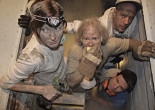
Hurricane Doom: Hurricanes With Dainty Names Aren’t Actually Dainty, Says Study
Art by Austin Smith
As anyone living in Houston knows, we’re a popular target for hurricanes. And why wouldn’t we be? We’re perfectly situated on the Gulf, we’re flat like a Ken doll’s not-so-naughty bits, and we’re a trendy new place to be. Fuck you, Houston’s awesome.
But no matter how many online top 10 lists we grace, hurricanes take up a lot of room in our negative column. And big nasties like Ike and overhyped ones like Rita (which can be just as damaging, we learned) have really brought hurricane preparedness into sharp focus. Highlighting safe routes, FEMA’s hurricane kits and The Annual Houston Healthcare Hurricane & Emergency Preparedness Summit are the results of Houston’s hurricane problems.
Unless the hurricane has a girly name.
A new study from researchers at the University of Illinois and Arizona State University, published in Proceedings of the National Academy of Sciences for the United States of America (PNAS), says we take storms with female names less seriously. Consequently, they have higher death rates.
The authors compared death rates for six decades of storms (minus Katrina and Audrey, due to their being less hurricane and more shitstorm). They found an average of 45 deaths for so-called female hurricanes and an average of 15 deaths for so-called male hurricanes. And the internets quipped, “Way to lean in, ladies!”
Then, co-author Kiju Yung ran six experiments on six different groups of volunteers. When presented with just gendered hurricane names (Victor vs. Victoria, Danny vs. Kate, etc.), each group took the male name more seriously. For example, when asked how likely they were to evacuate from Hurricane Alexander versus Alexandra, Alexander was the winner.
From the study: “Using names such as Eloise or Charlie for referencing hurricanes has been thought by meteorologists to enhance the clarity and recall of storm information. We show that this practice also taps into well-developed and widely held gender stereotypes, with potentially deadly consequences.”
The results don’t show blatant sexism, with people consciously choosing to ignore hurricanes with female names. Instead, says co-author Sharon Shavitt, “This suggests that the effects in the main experiments are implicit in nature.” When the volunteers were directly asked whether a male hurricane was more dangerous, answers were split.
But faster than you could say “sneaky sexism”, other academics and researchers pointed out the flaws in their evidence. And they made some excellent points.
For example, hurricanes were given exclusively female names until 1978 and 1979. On top of that, National Geographic points out, hurricanes have decreased in deadliness over time.
The authors analyzed pre and post-1979 data and argued there was a connection with the femininity of the name-Hurricane Fern was less likely to kill than Hurricane Belle, says Shavitt. However, the authors also argued they didn’t have enough usable data when splitting the storms by 1979 too. So, which is it? Not enough data, or definite connection?
The authors addressed this in a published response to the study’s critics. “Although it is true that if we model the data using only hurricanes since 1979, this is too small a sample to obtain a significant interaction. When we model the fatalities of all hurricanes since 1950 using their names’ degree of femininity, the interaction between name-femininity and damage is statistically significant. That is a key result.”
When the authors analyzed post-1979 storms, they still found a … well I guess we’ll call it a death gap, even though it bums me out to type it. They found an average of 23 deaths for male storms compared to an average of 29 deaths for female storms.
They add, “Specifically, for storms that did a lot of damage, the femininity of their names significantly predicted their death toll.”
Critics point out other factors that could skew the results, like where the respondents lived (e.g. someone on the coast may have a different response than someone in the Midwest). Jeff Lazo, economist at the National Center for Atmospheric Research, said, “Trying to suggest that a major factor in this is the gender name of the event, with a very small sample of real events, is a very big stretch.”
In the aforementioned response, the authors point out their findings were consistent across the board from a volunteer base of 18 to 81. So regardless of where or how they lived, the respondents consistently were more threatened by male hurricanes. Which is sexism, unintentional or no.
However, more in-depth research will be needed before any naming policies change. As several critics have pointed out, the study did not control for a variety of other social variables that affect preparedness. I doubt one study could. As the authors have said, this is a good place to begin the conversation about gender bias in hurricanes, not a definitive source.
And finally, one last gem from Jason Samenow at Washington Post: “An interesting aside: in reading press accounts and critiques of this study, I’ve anecdotally found criticism from men about this study much harsher than from women. Gender bias on a study about gender bias?”
Let’s just get some water bottles, find our evacuation routes and pack some feminist literature into our hurricane kits. And to show we really mean business, let’s change hurricane names into something really memorable, like Hurricane Doom or Hurricane Ruination-or name them after really scary men and women, like Hurricane Medusa or Hurricane Slender Man. (Too soon?)




You must be logged in to post a comment Login